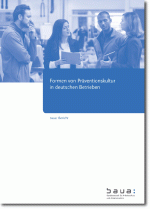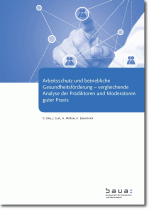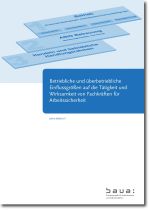- Project number: F 2342
- Institution: Federal Institute for Occupational Safety and Health (BAuA)
- Status: Completed Project
Description:
Executive management, occupational safety officers, occupational physicians and employee representatives all have a decisive impact on the internal health and safety culture in an organisation. This is because they shape the operational assessment of the manageability of risks, the perception of what the genuinely relevant risks are and of what is considered the "right" strategy for countering them. BAuA's research project "Drivers and barriers of the implementation of occupational health and safety measures in relation to company characteristics (F 2342)" has determined which of these within the company valid orientations and basic assumptions prevail among specialists and managers.
On the basis of 50 qualitative (group) interviews with those responsible for occupational health and safety, i.e. owners and executive staff as well as experts with responsibilities in this field (occupational health and safety officers, occupational physicians and employee representatives), the project managed to extrapolate five typical patterns of orientation by using Ralf Bohnsack's "documentary method". These five patterns were described as forms of prevention culture. The resulting typology is based on an attribute space with the dimensions of "risk framing", "interaction focus" and "understanding of occupational health and safety". The specific manifestations of these dimensions of meaning can have impeding or promoting effects on a good configuration of occupational health and safety.
In terms of a framework of orientation, "risk framing" means the prevailing judgements and/or perceptions concerning the manageability of risks in a company, as well as the resulting ideas on how best to handle these risks. The “interaction focus” dimension was developed on the basis of the system theory as described by Niklas Luhmann, which assumes that two essential task-related areas of organisations consist in internal integration (values, norms, interaction within the company) and external adaptation to organisational environments (laws, the public sphere, interaction with external systems). The qualitative analysis of the conducted (group-) interviews showed that the focus of priorities between these two extremes is also decisive to the configuration of the culture of prevention. The "understanding of occupational health and safety" was identified as a third dimension of the attribute space. It describes the internal discourse about occupational health and safety within the company and what is seen as a part of it by the various relevant stakeholders. It might be that almost only technical measures and approaches are discussed or that a company focuses primarily on employees’ behaviour - in contrast to companies that exhibit a comprehensive understanding, which includes both technical and organisational measures as well as individual-related measures and measures regarding psychosocial risks and information.
The typology built on these three dimensions was validated by a standardised telephone survey of 375 companies. As a part of this survey, various statements, which were partially derived from the interviews, were read out to the respondents, who were then asked the extent to which they agreed with these statements. It was subsequently possible to cluster the degrees of agreement by factor analysis into five factors.. These factors reflected the qualitatively developed typology and its attribute space to a great extent. On this basis, a quantitative forecast of the distribution of the types among all companies in Germany became possible. The outcome of this forecast is that the "fault avoiders" type is most wide-spread (30% of all companies), followed by the "do-it-yourself proponents" type, with about 21%. The three other types, i.e. the "technicians", "systematicians" and "standard setters" account for between 16% and 17% of the sample.
Furthermore, a "quick assessment tool prevention culture" was developed for practitioners on the basis of the factor analysis. Both external and internal prevention experts can use this tool as an initial source of support for assigning a type of prevention culture to their own or an external company.
As an explorative mixed methods project, the present project highlights the combination of qualitative and quantitative analyses in the interests of application-oriented results.



